Time-out holidays for the soul in two monasteries in Upper Austria
Take a break from everyday life and visit one of these picturesque monasteries in Austria for the ultimate calming experience! We have two insider tips for a break for the soul for you Upper Austria discovered. We were once again in monasteries. We had never heard of these two before our trip. No wonder! Are you in a region of Upper Austria that is off the beaten track? Here you will find silence that makes a break in the monastery to relax. This is monastery vacation as it should be. The Benedictine monastery Lambach lies on the Traun north of the Alps not far from Wels. At the Inn is the Augustinian Monastery Reichersberg. From there it is not far to Bad Füssing, Passau or Linz, Both monasteries offer opportunities for a monastery holiday.
Treat yourself to a break for your soul to recharge your batteries
Looking for a quiet retreat from the hustle and bustle of modern life? A break for the soul means taking time to take care of yourself and relax. Perhaps you spend time in nature to meditate and organize your thoughts. A break for the soul is like a journey to yourself, where you can recharge your batteries and bring a breath of fresh air into your life.
Austria's monasteries offer an ideal retreat for spiritual solace and relaxation in a tranquil natural setting. Find out more about the benefits of a relaxing monk-style vacation and what to expect during your stay in these tranquil places.
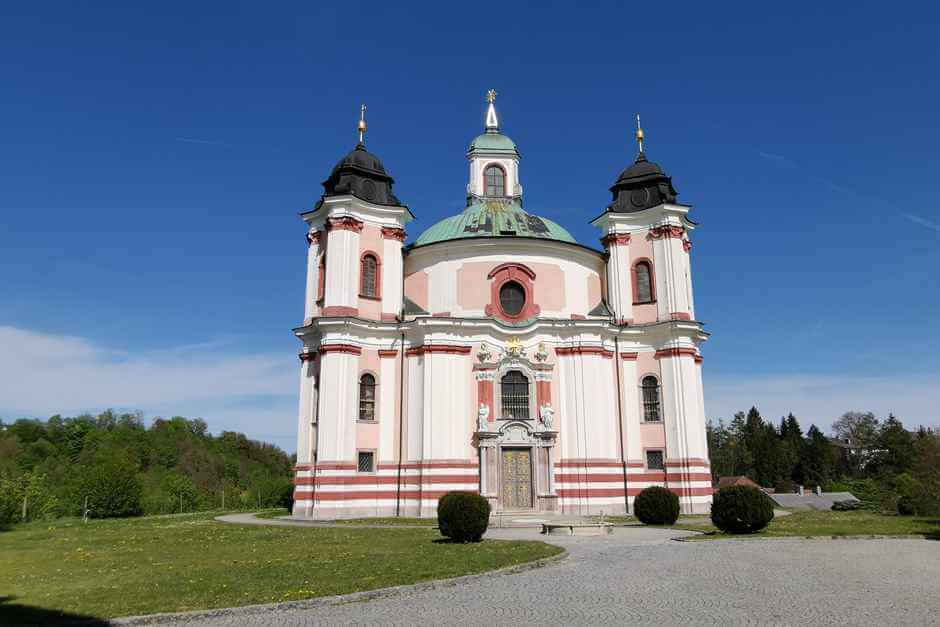
Pilgrimage at Stift Lambach and Stift Reichersberg with a break for the soul
Lambach Abbey is particularly suitable for hikers for a break for the soul. Here leads The Way of St. James from Wels to Schwanenstadt past. In addition, the Jerusalemweg by Lambach. But you don't necessarily have to go one of the long-distance hiking trails. If you accept journeys, you can do stages on the Marienweg hike that runs from Upper Austria to Altötting in Bavaria. There are also hikes in the vicinity of the pens. It is only a few steps down the mountain from the Reichersberg Abbey into the Inn Valley. There you can watch flocks of water birds in the Innau meadows that are native here. Lambach Abbey offers beautiful landscapes in the area that are ideal for walks. For example, on a hike along the Traun to the baroque church Paura, from which you have a view of the monastery.
Do you also know Pilgrimage routes in Germany?
Make a pilgrimage to the Paurakirche - a break for the soul
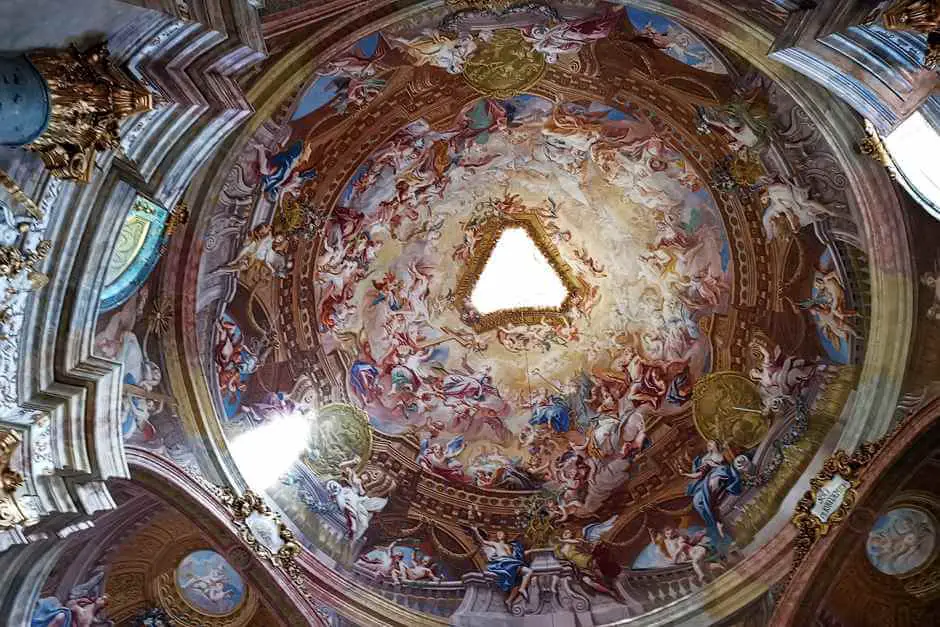
What you need for the pilgrimage - that has to go in the suitcase
- Comfortable hiking boots You should wear in any case, because the trails are sometimes long and lead uphill and downhill.
- A backpack you need, for example, enough drinks and a snack to take along for a picnic on the way.
- Also, think of one Raincover on the go. The weather can also change on longer hikes.
- The same goes for one sun hat, During hikes you are often exposed to the sun for a long time.
- Check our hiking checklistwhether you have packed everything you need for your hike.
The pens themselves also offer much for a monastery vacation for the soul. Here are the two monasteries in detail:
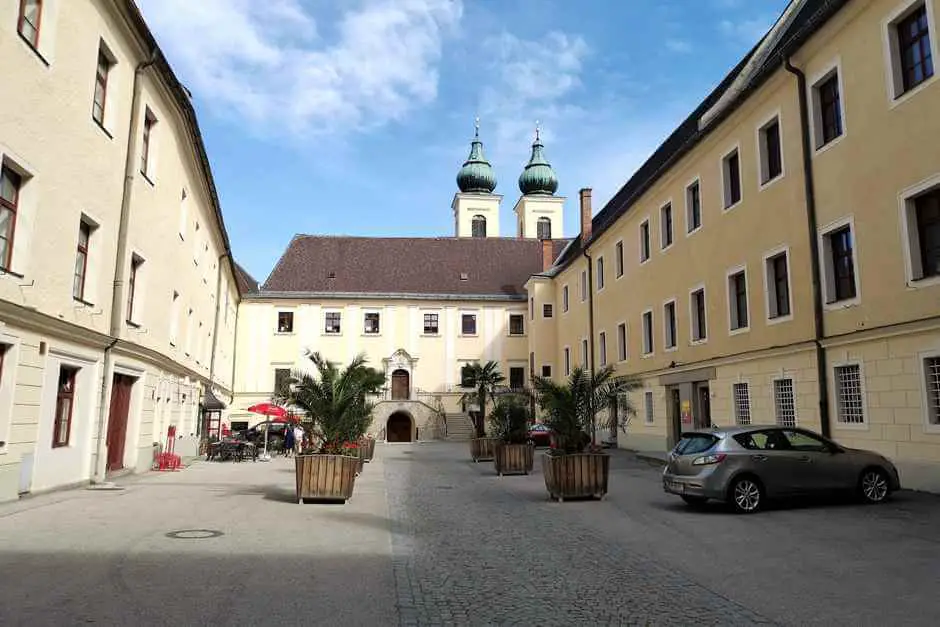
Time out for the soul of the Benedictine monastery Lambach near Wels
It is only twenty minutes from Wels, forty minutes from Linz, an hour from Passau or Salzburg and finally two hours from Munich by car to the Lambach Benedictine Abbey. We have passed nearby many times. However, we only heard about this pen when the invitation from Klösterreich fluttered into our house. We are all the more surprised when we discover what art treasures this monastery above the Traun has to offer. Founded in 1056 by St. Adalbero, Lambach Abbey is still a monastery today. At the same time it is a cultural center and houses an education center and a school.
Early Romanesque frescoes in the west choir
We arrive at Lambach Abbey at lunchtime. After lunch in the guest dining room of the monastery, where home-made food is served, we explore the monastery. A former student of the monastery school first shows us a room with early Romanesque frescoes. These date from the early days of the monastery in the 11th century. It was only rediscovered in the last century. Until then, they were hidden behind reinforcement walls that were built in to secure the towers. When these were finally removed in the 60s, the frescoes were found. In any case, they are among the most important examples of early Romanesque wall paintings in the German-speaking world.

However, the fresco room is not part of every guided tour of the monastery, as it can only accommodate a limited number of visitors. The best thing to do is to ask which tour includes the frescoes if you want to see them.
A baroque theater in the monastery for a break holiday for the soul
On the second floor of the monastery, Lambach Monastery surprises us with a baroque theater. It dates from the time of Abbot Amandus Schickmayr. He had it built in 1769. We had never seen a theater before when we visited the monastery. However, we learn that it was not that rare for monasteries to have theaters. There are, however, few that have survived to this day. Most of them have since been used for other purposes.
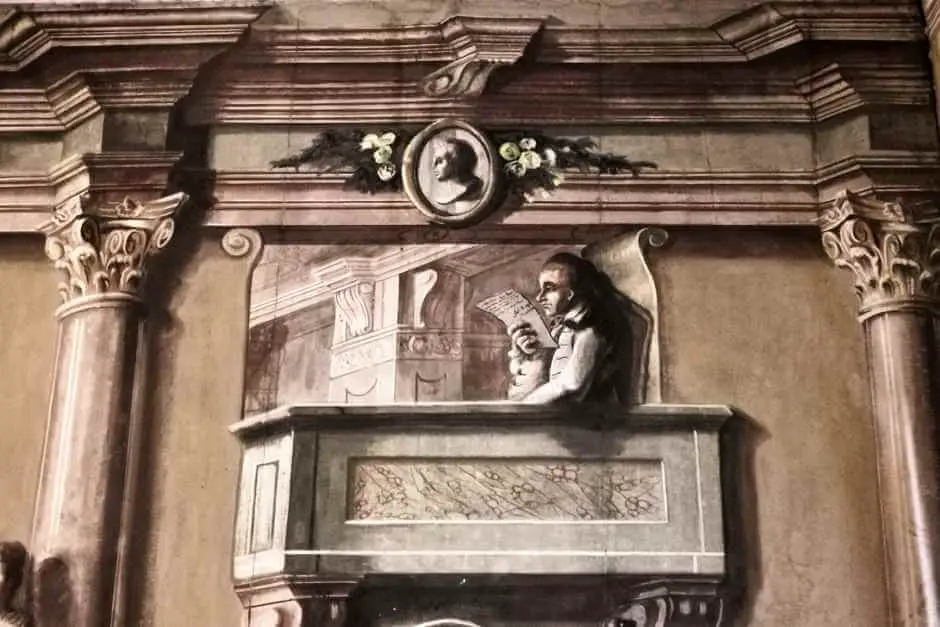
The theater at Stift Lambach is not only worth mentioning because it still exists today. It also hosted an important guest. Marie Antoinette, the daughter of Empress Maria Theresa, stayed at Lambach Abbey on her bridal trip to France. In her honor, on April 23, 1770, the play "The Short Wedding Contract" was performed, which Father Maurus Lindemayr from Lambach had written especially for this occasion. Today, the local theater association also performs its plays on the stage.

The Abbey Library
More than 50000 books are said to be in the Lambach Abbey Library. Nobody really knows, however, because they are not cataloged. Creating a catalog costs money, and that is what Lambach Abbey currently needs for other things. Nevertheless, a visit to the library is impressive. To protect the books and documents, the windows on both sides of the large library room are darkened. Therefore, the room looks a bit gloomy at first. If your eyes get used to the twilight, you will see some unusual things next to the books that fill the shelves in several layers.
A desk with a quill in an inkwell is reminiscent of Wolfgang Amadeus Mozart. He is said to have written a letter to his mother in the monastery library when he was on the way to Salzburg with his future wife to introduce her to his family. Today the table is used for special tours. An actor from the local theater group appears as Mozart and shows how he worked at his desk. Not only illustrious guests used the abbey library to work. A rotating lectern shows how the monks could use several books at once for research if they were writing their own works. A kind of desktop of the Middle Ages in which several pages were open at the same time.
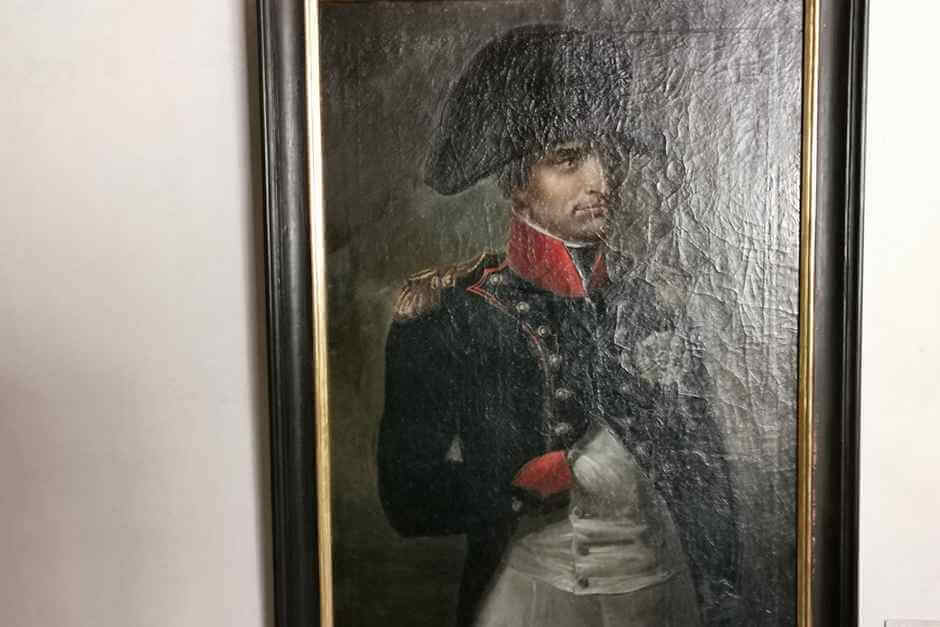
In the monastery museum we then find out that not all famous guests were welcome in the monastery. A painting by Emperor Napoleon Bonaparte reminds us that in 1809 he used Lambach Abbey as quarters during the Austro-French War.
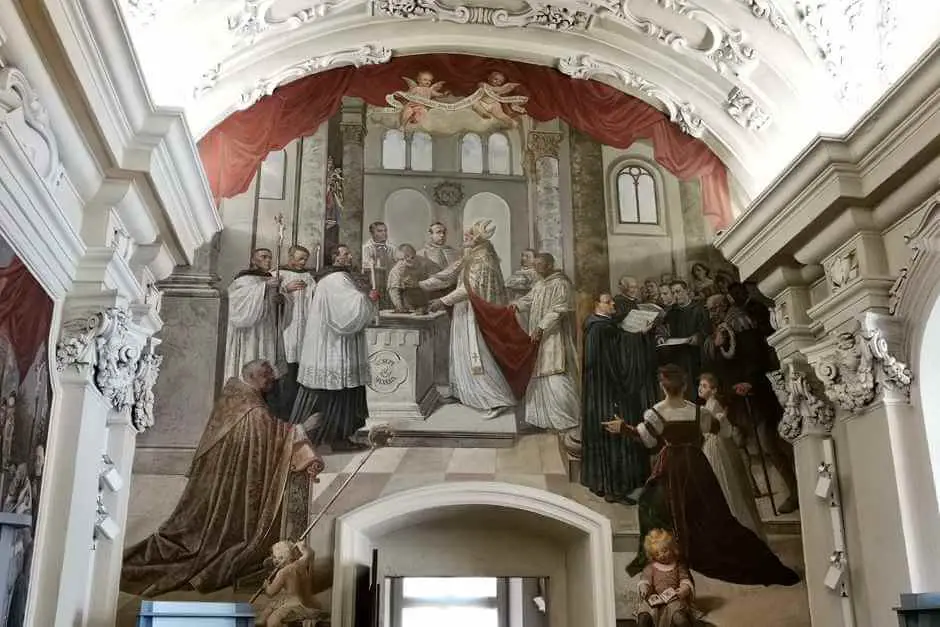
Worth seeing rooms and a monastery garden
Other halls that expand the abbey’s artistic wealth are the former chapter room with stucco work and the summer refectory, which is now only used for banquets and events throughout the year. Here the monks celebrate Easter with their families. However, the monks' everyday dining room is not open to the public.

After all, the monastery garden is a place of calm, perfect for a break for the soul. In the garden there are statues, including figures that represent the four continents of Europe, Africa, Asia and America. Also worth seeing are the dwarf figures that symbolize various professions.
The collegiate church
The collegiate church looks unusual with its single nave nave. It concludes our tour of the Lambach Benedictine Abbey. With its ceiling frescoes and the high columned altar, it sets a final highlight in the overall baroque ensemble of the monastery.

Time out for the soul
So much enjoyment of art makes you hungry. So for dinner we meet Father Severin in the Lambach monastery cellar, which is located in the inner courtyard of the monastery. Here we end our day with good cuisine (egg spaetzle with mixed salad) and interesting conversations about monastery life.
Stay overnight at the Lambach Abbey
You can spend the night in the guest wing of the monastery in single, double and triple rooms (only by appointment).
There is also a pilgrim's quarters in a room with five beds. (Reservation not possible, for day pilgrims, only one donation is required)
Benedictine monastery Lambach
Monastery Square 1
4650 Lambach
Austria
Tel. + 43 / 7245 / 217 10
empfang@stift-lambach.at

A break for the soul in Stift Reichersberg in the Innviertel
The Augustinian canons of Reichersberg is located directly on the Bavarian-Austrian border. From there you can look out over the Inn Valley to Bad Füssing, which can be reached in just 15 minutes via the Inn Bridge near Obernberg. It also only takes half an hour to get to Passau and about an hour by car to Linz or Salzburg. After all, it takes about two hours from Munich to drive to Reichersberg Abbey.
History
Stift Reichersberg probably dates back to the year 1084. That's not exactly known, because there is no official certificate of incorporation. What is certain, however, is that the donation was donated by Wernher and Dietburga von Reichersberg. The couple donated their castle to a monastery after their son Gebhard drowned in a hunting accident at the Inn. Although this decision did not appeal to the brother and nephew of the lord of the castle, they donated the castle to the order. The Augustinian canons have been the owners of Reichersberg for more than 900 years.
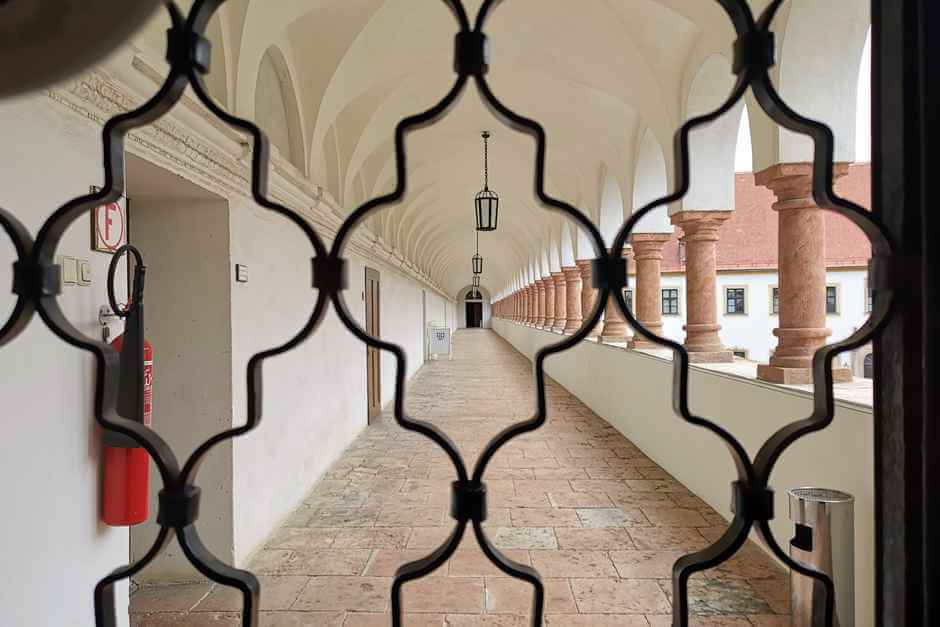
However, this did not always go without problems. In 1624 the Romanesque-Gothic monastery burned down. After that, the monks rebuilt it in the baroque style. This is how the monastery looks today. During the Nazi era, the Reichersberg Abbey housed an aviation school. While Hitler's henchmen dissolved other monasteries, the monastery was able to survive.
The Michael Fountain stands in the middle of the inner courtyard in honor of the Archangel Michael, who is also the patron of the monastery. In any case, it is at the center of events that take place every year in the Reichersberg Abbey, such as the biker fair at the end of April, the garden days at the end of May and the Reichersberg handicraft market in mid-November.
Baroque splendor rooms
Reichersberg Abbey has a number of baroque halls used for events. Not all of them are accessible during a congregation tour. However, they can be rented for events, workshops or seminars. Also for concerts these rooms are available. They are so beautiful that we do not want to withhold them from you. But see for yourself:
The Bavarian Hall
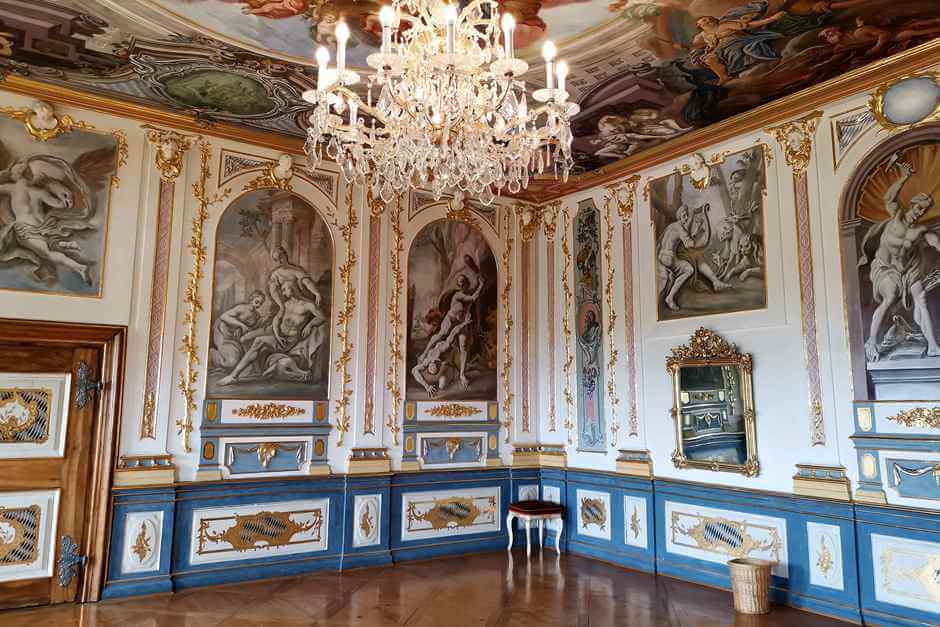
The Augustini hall
Every summer, concerts are held in the Augustini Hall in the Reichersberg Abbey under the motto "Festive Music in the Abbey". In this ambience it is certainly an impressive experience.
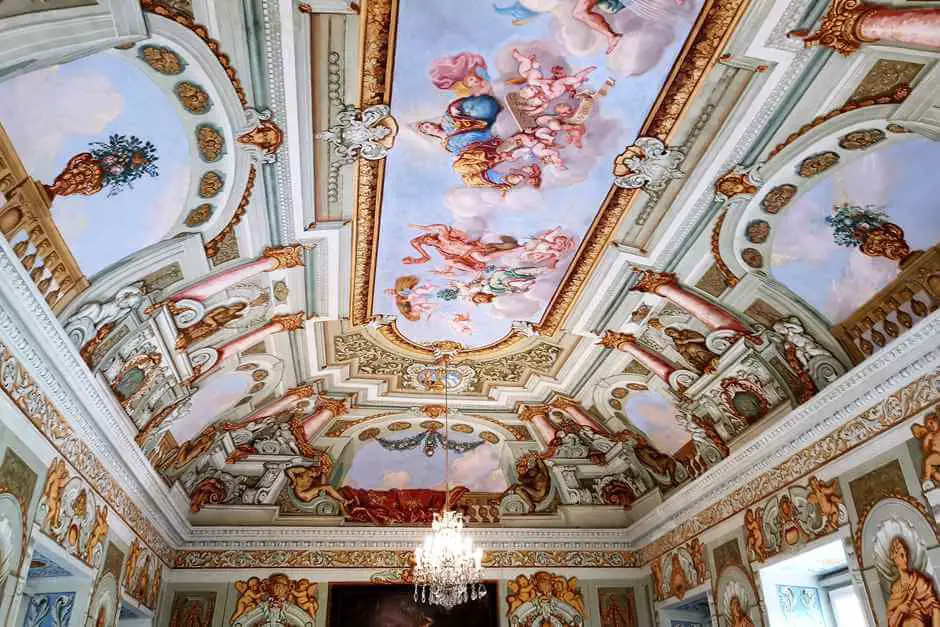
The pin guidance
After our look behind the scenes, we will meet Father Thomas for a guided tour of the monastery. He warmly welcomes us with a smile. “You will surely notice that I am not from Austria,” he laughs. “I am originally from Tübingen,” he says in the Swabian dialect. “But I've been living in Austria for many years now. I was also in Lower Austria for many years. ”Reichersberg Abbey has its own vineyards there.
The collegiate church
First, Father Thomas leads us into the baroque collegiate church. In addition to a ceiling fresco, there are works by Schwanthaler. A grave slab in a side altar reminds of the donor family.
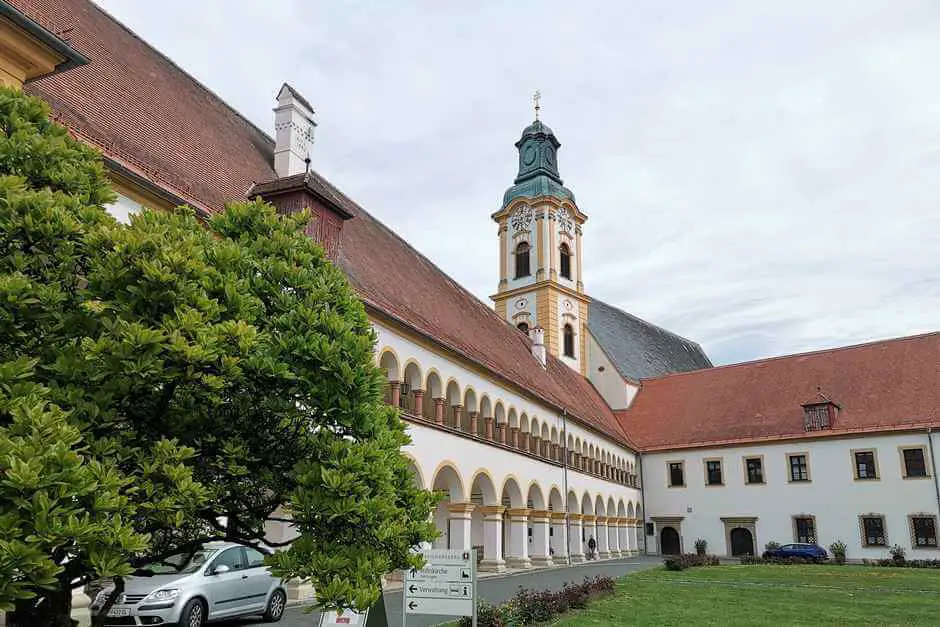
The monastery museum
Next door at the Abbey Museum, Father Thomas first shows us the museum's exhibition rooms with an old bell, a small chapel and a corridor and side rooms displaying works of art in the collegiate domain. Among them are works by Schwanthaler and Carloni.

The Abbey Library
During the guided tour of the monastery, we also see the monastery library. However, Father Thomas does not know how many books are in it. The library is also worth seeing because of the ceiling painting.
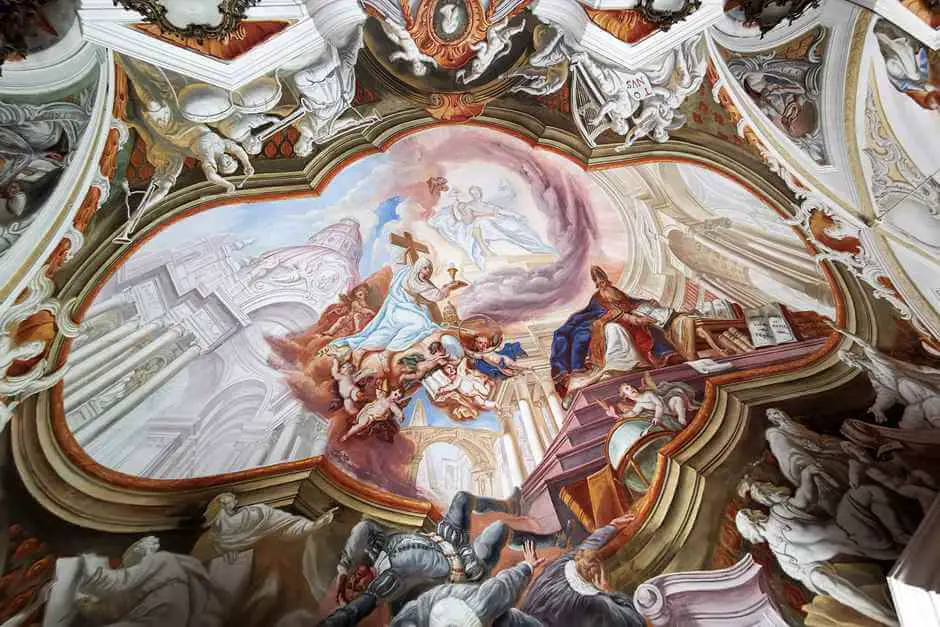
The pin fountain
The water that supplied the pen once flowed here. Today, however, only the fountain and the stucco work remain.
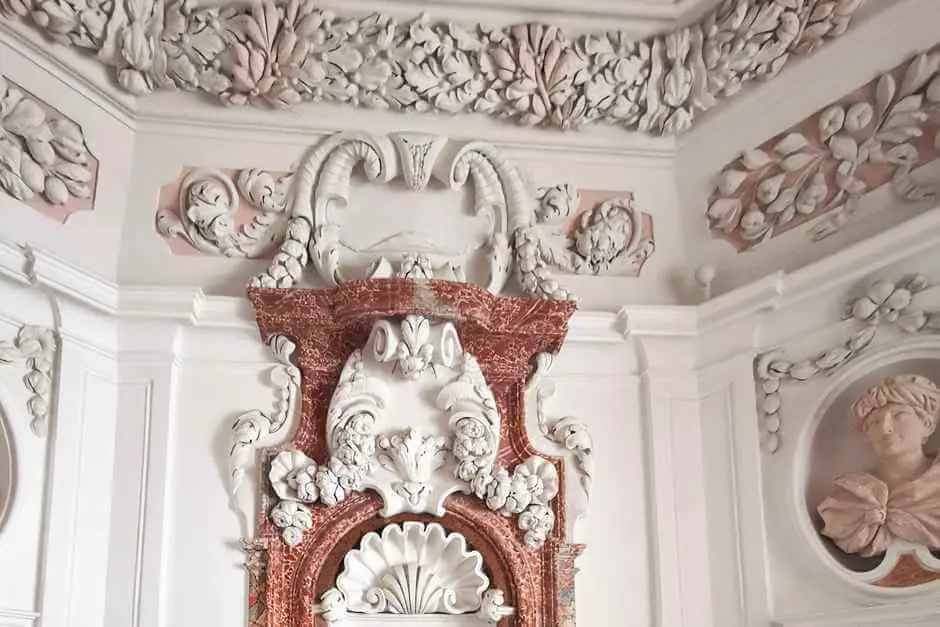
The Summer Refectory
What used to be the monks' summer dining room has now become too big. Therefore, today we dine in the monastery wing, which is reserved for the monks. You can see the former refectory with its stucco work on the monastery tour. A visit to the refectory fits into a time-out holiday for the soul.
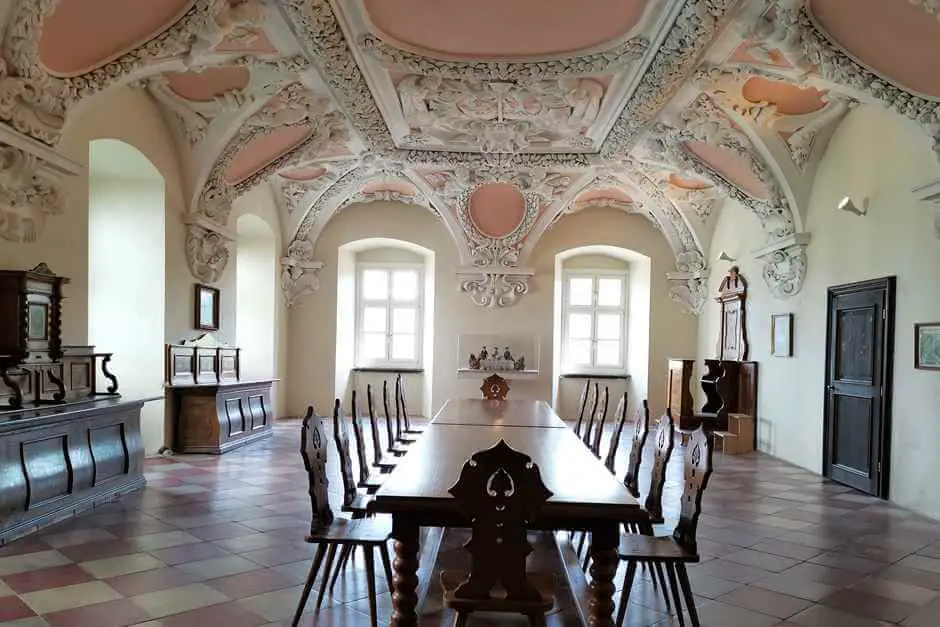
In the monastery shop
Finally, we don't want to miss the monastery shop at Reichersberg Abbey. There we can buy our own wines from Lower Austria and Deutschkreutz in Burgenland buy. There are also local products. I especially liked the monastery coffee and a coffee liqueur, which we were able to try during our visit. Both are products from the vicinity of the monastery. Finally, right next to the monastery is a coffee roastery that roasts highland coffee from pure Arabica beans. In addition to other coffee delicacies, it produces a special monastery coffee and the 9 Beans coffee liqueur. For us, enjoyment is part of a time-out holiday for the soul.

The Herrengarten
At the end of our visit to the Reichersberg Abbey, we finally visit the Herrengarten directly in front of the abbey gates. Here we relax on a bench in this place of silence and enjoy the last moments of our vacation for the soul in the Reichersberg Abbey.
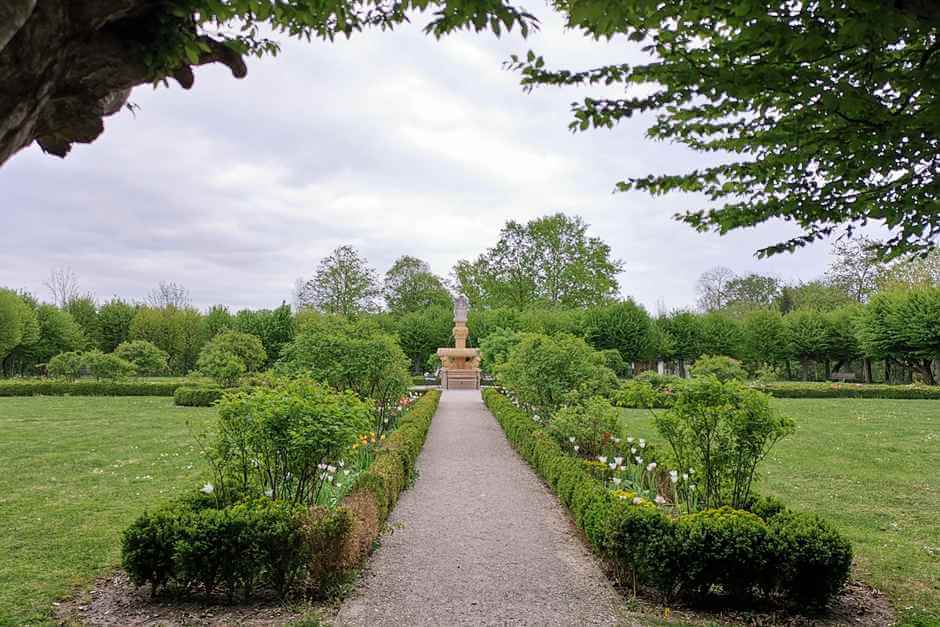
Stay overnight at Stift Reichersberg
Stift Reichersberg offers accommodation in 35 double and single rooms *** category.
It is a bed & bike accommodation and therefore well suited for cycle tourists and for a break for the soul.
Stift Reichersberg
A-4981 Reichersberg 1
Austria
Phone + 43 (0) 7758 2313-0
E-Mail: info@stift-reichersberg.at
Our conclusion:
The two monasteries, Lambach Abbey and Reichersberg Abbey, are real insider tips for anyone looking for peace and quiet away from the tourist crowds. They are therefore perfect for a time-out vacation for the soul. Both are also located in a landscape that is ideal for hiking and cycling. However, what impressed me the most are the art treasures that the two monasteries boast. Anyone who has not yet been a baroque fan is guaranteed to be in these two monasteries. The collegiate churches as well as the libraries and the halls of the two monasteries are pure art enjoyment. The well-preserved frescoes in Lambach Abbey and the Paura Church, just a few kilometers from this monastery, are also particularly worth seeing.
Lambach Abbey and Reicherberg Abbey are worth a visit
Both Lambach Abbey and Reichersberg Abbey are well suited for excursions from the south of Bavaria, from Passau, Munich or from the regions in Upper Austria or in the Salzburger Land. If you want, you can also extend this to several days and explore the surroundings of the monasteries in more detail.
Time out for the soul in and around Munich
The 33 places to pause, listen and blossom that Irmi Baumann presents in her book about Munich show that there is not only time out for the soul in the monastery. It's about places where you can find deceleration in nature. There are also tips for observing animals and relaxation exercises. Anyone looking for such places in the big city will find wonderful recommendations for natural places and places to relax in this book. She also has insider tips for the south and west of Munich where you can find such places in nature. The East alone, with only two proposals, comes up a little short. Order here*.
If you purchase via a link marked *, we receive a commission, which we use to run this blog.
Questions and answers about a vacation for the soul:
What is a break vacation for the soul?
A soul escape is a type of vacation where you take time to relax and unwind. It's about letting go of stress and worries and recharging your batteries.
How can I plan a break vacation for the soul?
First you need to find somewhere to relax, such as a quiet beach resort or secluded mountain chalet. Then you can plan activities that relax you, like nature walks, yoga, meditation, or a day at the spa.
Why is a vacation break important for the soul?
A break for the soul is important because it can help you de-stress and unwind. It can also help you organize your thoughts and feelings and change your perspective.
How long should a break vacation for the soul last?
A soul break vacation should last as long as you need to relax and unwind. This can be a weekend or a whole week. It's important that you don't feel stressed and that you have enough time to recover.
What are some activities I can do during a soul break vacation?
Some activities that you can do during a soul time vacation include nature walks, yoga, meditation, reading, days at the spa, days at the beach or in the mountains, and spending time with friends or family. It's about finding activities that relax you and make you happy.

Do you know this?
- Stift Lilienfeld
- This is what a monastery holiday at St. Paul Abbey in Lavanttal is like
- Time out at Stams Monastery in Tyrol
- Sankt Lambrecht Hiking - Slow Travel in Styria
- The Viktualienmarkt in Munich
- A temporary break - three monasteries in Austria
- Rheinhessen wine for beginners
A trip or a weekend tour to these two monasteries is definitely a must Slow Travel Experiencehow beautiful it can hardly be. Discover more monasteriesworth a visit here. A monastery in Upper Austria that we can recommend for this is Stift Schlägl in the Mühlviertel.
Source time out Vacation for the soul: research on site. We thank you in any case Klösterreich as well as the two monasteries for the invitation to this research trip. However, our opinion remained unaffected.
Text Time out Vacation for the soul: © Copyright Monika Fuchs and TravelWorldOnline
Photos Time out Vacation for the soul: © Monika Fuchs and TravelWorldOnline
Videos Time out vacation for the soul: © Petar Fuchs and TravelWorldOnline





Taking a break and feeling the breath of time would be a good chance to examine yourself and your own world view. Also heard from the local medicinal waters. Thanks for the tip for the holiday!
This is true. We've heard of it, but have not tested yet.
very nice photos and described with great care!
Thank you very much, dear Angelika. I am reading your reports with pleasure.
Greetings,
Monika